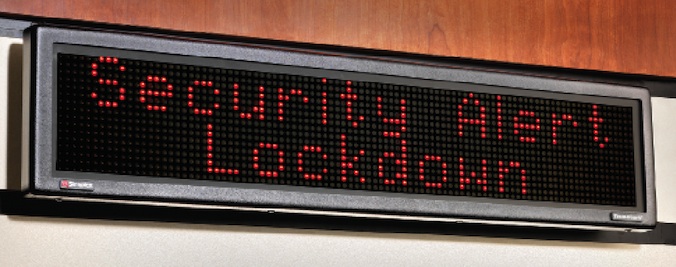AEC Building Teams should work with their clients to conduct a version of the “threat assessment” described in this Special Report.
Such an evaluation should start at the property line and work inward. Many of the questions that a security team would use in a K-12 threat assessment could be applied to office buildings, hospitals, outpatient facilities, hotels, university buildings, stadiums, convention centers, municipal and state government buildings, and other places of congregation:
• Are there exterior conditions that could compromise security—untrimmed bushes that could provide cover for intruders, or unlocked trash receptacles that could become hiding places for weapons or explosives?
• Are exit doors fitted with alarms in case they are propped open?
• Are visitors, tenants, and other building users “funneled” to a main entry point where surveillance at various levels can be conducted?
• Do the security cameras work? Does anyone monitor them? How often?
As our report shows, design and technology are vital to the safety of children, teachers, and staff in schools, but if the staff and users of other building types are not educated in emergency procedures and don’t rehearse them, the damage from an untoward incident could rise significantly.
Staff training and periodic rehearsals in security measures should be de rigueur for virtually every kind of building with public access—hospitals, retail and office facilities, college student unions, performing arts centers, movie theaters, and so on.
Our report raised the sustainability vs. security question for schools, but that quandary also applies to other public or quasi-public building types and uses, such as office buildings, college residence halls and classrooms, hotel lobbies, and restaurants. Owners and users of these buildings—not to mention the architects, engineers, and construction professionals who design and build them—all want as much natural light as the energy model will permit, but daylighting requires lots of glass, and that could raise concerns about security. Building Teams need to work with their owner clients to balance these occasionally conflicting demands.
One of the surprising findings from our exclusive survey of BD+C subscribers was that fully one-third of respondents (33.8%) said they were unfamiliar with Crime Prevention Through Environmental Design, and that only about one in six respondents (16.4%) said they (or their firms) used CPTED principles on a routine basis in K-12 projects.
These respondents were selected on the basis of their heavy involvement in school projects. If they don’t know about CPTED for schools, is it also the case that those who design and build other kinds of public or semi-public facilities have no training in security-related matters? That would be very disturbing.
(Editor's Note: This article is the fourth in BD+C's five-part special report on security design for K-12 school projects. Read the full report.)
Related Stories
| Jun 1, 2012
New BD+C University Course on Insulated Metal Panels available
By completing this course, you earn 1.0 HSW/SD AIA Learning Units.
| May 31, 2012
2011 Reconstruction Award Profile: Seegers Student Union at Muhlenberg College
Seegers Student Union at Muhlenberg College has been reconstructed to serve as the core of social life on campus.
| May 29, 2012
Reconstruction Awards Entry Information
Download a PDF of the Entry Information at the bottom of this page.
| May 24, 2012
2012 Reconstruction Awards Entry Form
Download a PDF of the Entry Form at the bottom of this page.
| May 9, 2012
Construction Defect Symposium will examine strategies for reducing litigation costs
July event in Key West will target decision makers in the insurance and construction industries.
| Oct 17, 2011
Clery Act report reveals community colleges lacking integrated mass notification systems
“Detailed Analysis of U.S. College and University Annual Clery Act Reports” study now available.
| Sep 14, 2011
Research shows large gap in safety focus
82% of public, private and 2-year specialized colleges and universities believe they are not very effective at managing safe and secure openings or identities.












